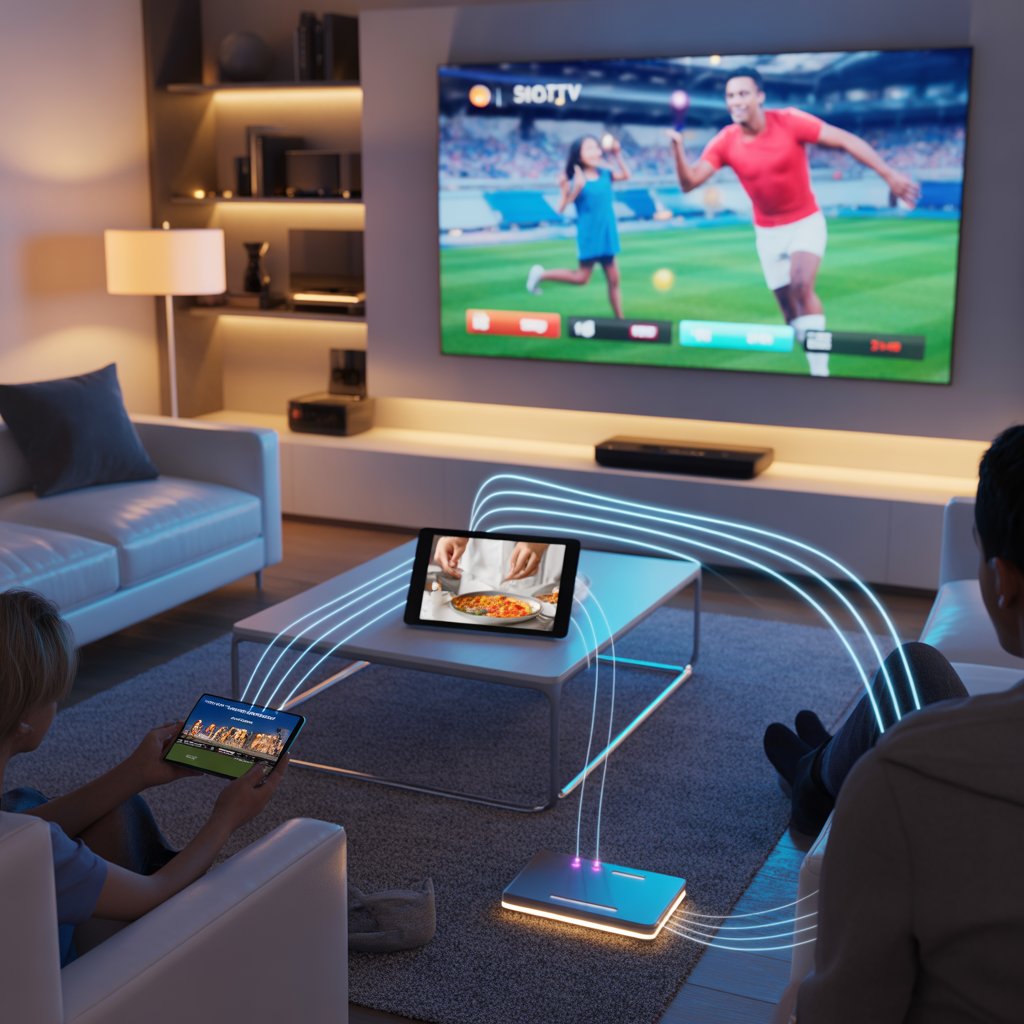Multiple devices in a home using IPTV

Multiroom IPTV: The Ultimate Guide to Streaming in Every Room
Published: • Reading time: ~10 min
Multiroom IPTV lets you stream IPTV channels and on-demand content simultaneously to multiple TVs and devices in the same home or property using a single IPTV account or central server. It enables different rooms to play different channels or the same content independently — ideal for families, hotels, and businesses.
If you want to watch TV in the living room, stream a movie in the bedroom, and have kids watch cartoons in the playroom — all at the same time — multiroom IPTV makes it possible. This complete, expert-friendly guide explains what multiroom IPTV is, how it works, how to set it up, and how to optimize performance and security for both home and business environments.
Below you’ll find step-by-step setup instructions, device recommendations, troubleshooting tips, and best practices so you can deploy a reliable multiroom IPTV system that runs smoothly and scales with your needs.
Why Multiroom IPTV Is So Popular
The rise of smart devices and faster home internet has made multiroom IPTV a mainstream choice for households and small businesses. Compared to traditional cable, multiroom IPTV offers flexibility, easier device management, and often better value.
Top benefits of multiroom IPTV
- Flexible viewing: Different rooms can watch different channels simultaneously.
- Cost-effective: Use one subscription across multiple devices (depending on provider rules).
- Device interoperability: Works with smart TVs, Android boxes, streaming sticks, tablets, and phones.
- Central management: Control and monitor streams through apps or an admin portal.
- Scalable: Start with two rooms and expand to as many as your network and provider allow.
How Multiroom IPTV Works
At its core, a multiroom IPTV setup relies on three components: the IPTV content source (server or provider), your home or building network, and the client devices that receive the streams.
- Content source: A central IPTV server or a provider portal supplies channels and VOD (video on demand).
- Network distribution: Streams are delivered over LAN or Wi-Fi to client devices.
- Client devices: Each TV or device runs an IPTV app (M3U/portal) and receives its own stream.
Some IPTV providers include multiroom support out of the box; others require add-on licenses. Always confirm the provider’s multi-login policy before purchasing.
Who This Guide Is For
Beginners and home users: Step-by-step setup and device recommendations. Small businesses and hoteliers: Tips for scaling, VLANs, and professional deployments. Tech-savvy users: Advanced tips for QoS, VLANs, and performance tuning.
Multiroom IPTV Setup: Step-by-Step
Follow this checklist to get a basic multiroom IPTV system running quickly.
1. Choose a reliable IPTV provider (multiroom support)
Pick a provider that explicitly supports multiple simultaneous logins or multiroom plans. Ask about connection limits, allowed concurrent streams, and portal formats (M3U, Xtream Codes, or custom portals).
[Link to related article on choosing the best IPTV provider]
2. Ensure adequate internet and network hardware
- Target at least 25–50 Mbps for a few HD streams; higher for multiple 4K streams.
- Prefer wired Ethernet to Wi-Fi for critical TVs to reduce buffering.
- Use a modern router (dual-band or tri-band) or a mesh Wi-Fi system for large homes.
3. Install IPTV apps on each device
Popular client apps include TiviMate, IPTV Smarters Pro, XCIPTV, and Smart IPTV. For smart TVs and Android boxes, use the native app or sideload where supported.
4. Configure playlists or portal URLs
Add the M3U playlist or portal URL to each client app. If your provider supports username/password logins, configure each device with those credentials.
5. Test, monitor, and optimize
- Test channel switching and stream stability on each device.
- Measure real-world bandwidth during peak use.
- Tweak router QoS (Quality of Service) to prioritize IPTV traffic if necessary.
Example: 3-Room Multiroom IPTV Setup
| Room | Device | App | Connection |
|---|---|---|---|
| Living Room | Smart TV (LG/Samsung) | TiviMate | Ethernet |
| Bedroom | Fire TV Stick 4K | IPTV Smarters | Wi-Fi (5 GHz) |
| Kitchen | Tablet | XCIPTV | Wi-Fi (2.4 GHz) |
Best Devices for Multiroom IPTV
Choose devices that can decode HD/4K streams and run IPTV clients reliably.
- Amazon Fire TV Stick 4K — affordable, widely supported.
- Android TV boxes — flexible and low-cost for many rooms.
- Smart TVs (LG, Samsung, Sony) — native convenience.
- Nvidia Shield — high-performance for 4K and advanced features.
- Dedicated IPTV set-top boxes (MAG, Formuler) — for advanced setups.
Troubleshooting Common Multiroom IPTV Issues
Buffering or poor stream quality
- Switch a device from Wi-Fi to Ethernet.
- Reduce stream resolution (4K → 1080p) on congested links.
- Restart the IPTV app, device, or router.
Account or login conflicts
If channels fail to load only on some devices, check your provider’s simultaneous login limits. Contact support to add multiroom licensing if required.
App crashes or freezes
- Clear the app cache or reinstall the client.
- Check for firmware updates on the device.
Multiroom IPTV vs. Traditional Cable
Comparing the two helps show why multiroom IPTV often makes more sense for modern users.
| Feature | Multiroom IPTV | Traditional Cable |
|---|---|---|
| Flexibility | Streams to any device | Limited to set-top boxes |
| Cost | Single subscription (often) | Fees per box |
| Content | Global channels, VOD | Local/regional channels |
| Control | App-based, remote admin | Manual hardware |
| Quality | HD/4K supported | Often HD only |
Advanced Tips & Business Use Cases
For hotels, bars, and enterprise deployments, consider professional network design and licensing.
Business best practices
- Use VLANs or managed switches to separate IPTV traffic from guest or work networks.
- Deploy a captive portal or central admin for guest channels in hotels.
- Consider SLAs and redundancy for mission-critical setups.
Network optimization tips
- Enable QoS to prioritize IPTV traffic.
- Use multicast where supported to reduce bandwidth when sending identical streams to many devices.
- Monitor bandwidth usage and scale upstream capacity as needed.
For deeper technical reads on VLANs and QoS, see resources like [Link to authoritative networking guide].
Security & Privacy for Multiroom IPTV
Security is often overlooked but is important when running multiple devices on a single network.
- Use strong router passwords and WPA3 or WPA2 encryption for Wi-Fi.
- Keep set-top boxes, smart TVs, and apps up to date with firmware updates.
- Avoid unverified free IPTV sources; they may carry security and legal risks.
- If privacy is a concern, consider a reputable VPN that supports router-level setup.
[Link to article on IPTV security best practices] • [Link to WHO report on mental health]
The Future of Multiroom IPTV
Multiroom IPTV will continue to evolve alongside smart homes and AI. Expect better voice control, more cloud-managed IPTV platforms, and improved synchronization across devices. Ultra-HD and lower-latency streaming will push multiroom systems toward near-broadcast quality in every room.
Ready to Deploy Multiroom IPTV?
Whether you’re setting up a family-friendly home system or building a hotel-grade IPTV deployment, the right combination of provider, hardware, and network design makes all the difference.
Next steps:
- Check your internet bandwidth and router capabilities.
- Choose devices that match your quality needs (HD vs. 4K).
- Confirm your IPTV provider’s multiroom policy and pricing.
